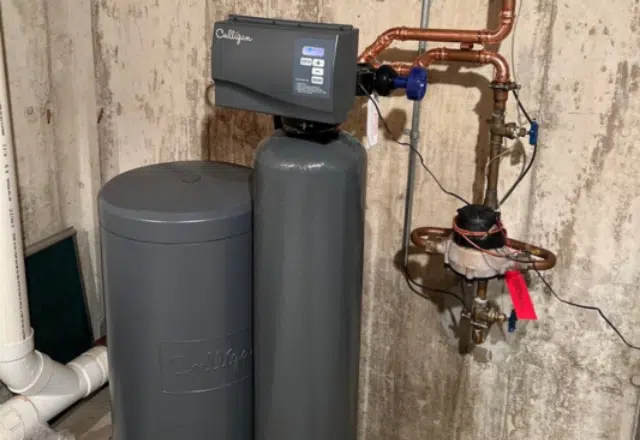
Water softeners are essential in managing water hardness by utilizing an ion exchange process, replacing calcium and magnesium ions with softer sodium ions. Regular water softener maintenance is crucial for ensuring your unit to provide soft water efficiently. This guide will detail seven vital areas to maintain for optimal performance of your water softener.
Before diving into maintenance tasks, familiarize yourself with key water softener components:
Understanding these parts is crucial for effective water softener upkeep and troubleshooting common issues.
A yearly water softener maintenance schedule should include these essential tasks:
Following this water softener tune-up checklist ensures optimal performance throughout the year.
Let me break down these costs:
Proper regeneration timing is crucial for water softener efficiency. Factors affecting regeneration frequency include:
Understanding how to service a water softener’s regeneration cycle can significantly impact its performance and longevity.
Regular water softener inspection should include:
These inspection points help identify potential issues before they become major problems.
Regular water softener maintenance doesn’t always require professional help. Many homeowners successfully perform basic water softener tune-ups themselves, saving both time and money. This DIY water softener maintenance guide will help you understand the essential components and steps for proper water softener care.
Regularly checking and replenishing salt in your water softener is vital for its regeneration cycle. The salt level should at least fill half of the brine tank to maintain the unit’s softening capacity. Using high-purity salt, such as evaporated salt pellets, ensures the most effective ion exchange process. Low-quality salts can lead to increased maintenance and reduced efficiency.
Annual cleaning of the brine tank is essential to prevent sediment and salt bridge buildup, which can significantly hamper the efficiency of your water softener. During cleaning, inspect for any salt bridges that form when salt crusts over but doesn’t dissolve, hindering the regeneration process. Keeping the brine tank clean ensures a consistent and efficient water level for the resin bed’s regeneration.
The resin bed is central to the softener’s functionality, facilitating the ion exchange. Over time, the resin beads wear out and may release fines into your water supply, indicating it’s time for replacement. Monitor the water quality for signs of resin bed deterioration and refer to your system’s manual for guidance on replacing the resin.
In areas with high sediment levels in water, installing a prefilter is crucial. Prefilters protect the softener from potential clogging and damage by removing contaminants before they reach the softener. This addition is particularly beneficial for well water systems or municipalities with high sediment content.
The type of water softener salt you use in your unit plays a significant role in its performance. While options like rock salt, solar salt and pellet salt exist, choosing a high-purity salt ensures less residue and more efficient ion exchange. Investing in 99% pure or higher salt pellets can significantly reduce the frequency of maintenance and enhance resin bed longevity.
Your water softener’s regeneration frequency might need adjustment depending on your household’s water hardness level. If you notice a decrease in water softness, consider increasing the frequency of regeneration cycles. This ensures the resin bed is adequately flushed and recharged for peak performance.
While regular preventative maintenance can be performed DIY, certain aspects like resin bed replacement might require professional assistance. Annual inspections by professionals can also identify potential issues that might not be evident during routine checks. Rely on certified experts for complex maintenance to ensure your water softener remains in top condition.
Regularly performing these simple maintenance tasks, coupled with professional annual service, will help keep your water softener running smoothly. Addressing minor issues promptly ensures uninterrupted access to soft water, enhancing the longevity and efficiency of your system.
When performing water softener system maintenance, watch for these common problems:
Early detection through regular water softener care can prevent costly repairs and system failures.
Symptom | Possible Causes | Maintenance Required | Priority Level |
Hard water | Low salt, Resin problems | Check salt, Clean resin | High |
Low pressure | Clogged filter, Resin bed issues | Replace filter, Clean resin | High |
Salty taste | Improper regeneration | Adjust cycle settings | Medium |
Brown water | Iron buildup | Clean resin bed, Iron treatment | High |
System won’t regenerate | Timer failure, Motor issues | Electrical check | Critical |
Different seasons require specific water softener upkeep approaches:
These seasonal adjustments ensure consistent performance throughout the year.
Q: How often should I clean the resin tank in my water softener?
A: Regular cleanings of the resin tank are essential for maintaining your water softener’s efficiency. It’s recommended to clean the resin tank at least once a year. This helps to remove any heavy metals or impurities that may hinder the water softening process.
Q: Is a specific type of water softener cleaner necessary for maintenance?
A: Yes, using a water softener cleaner specifically designed for your system is crucial. These cleaners help maintain the resin tank and other components in their purest form, ensuring optimal performance.
Q: How much water should be used during the regeneration process?
A: The amount of water used during regeneration depends on your water softener model. Generally, it ranges from several gallons to over a hundred gallons of water. Refer to your system’s manual for specific details about water usage.
Q: Can I use hot water during the water softener cleaning process?
A: It’s advisable to use warm or soapy water rather than hot water for cleaning. Hot water can potentially damage certain components of the water softener, such as the venturi valve.
Q: What is the function of a bypass valve in water softeners?
A: The bypass valve allows you to cut off water flow to the softener for maintenance or troubleshooting without disrupting the water supply to your home. It’s particularly useful during cleaning or if the system needs repairs.
Q: How do I know if the venturi valve in my water treatment system needs cleaning?
A: If you notice a decrease in water flow or efficiency, it might indicate a clogged venturi valve. Regular inspection and cleaning of the venturi valve, typically with plain or soapy water, can prevent this issue and ensure consistent performance of your water treatment system.
I bring over 9 years of dedicated plumbing experience to the table. As a seasoned professional in the plumbing industry, I've tackled a wide range of projects, from residential repairs to large-scale commercial installations.


After two decades maintaining industrial water treatment systems, I can verify these tips are golden. One additional suggestion: mark your calendar to check the brine tank’s salt bridges every equinox – it’s an easy way to remember and prevents most common issues.